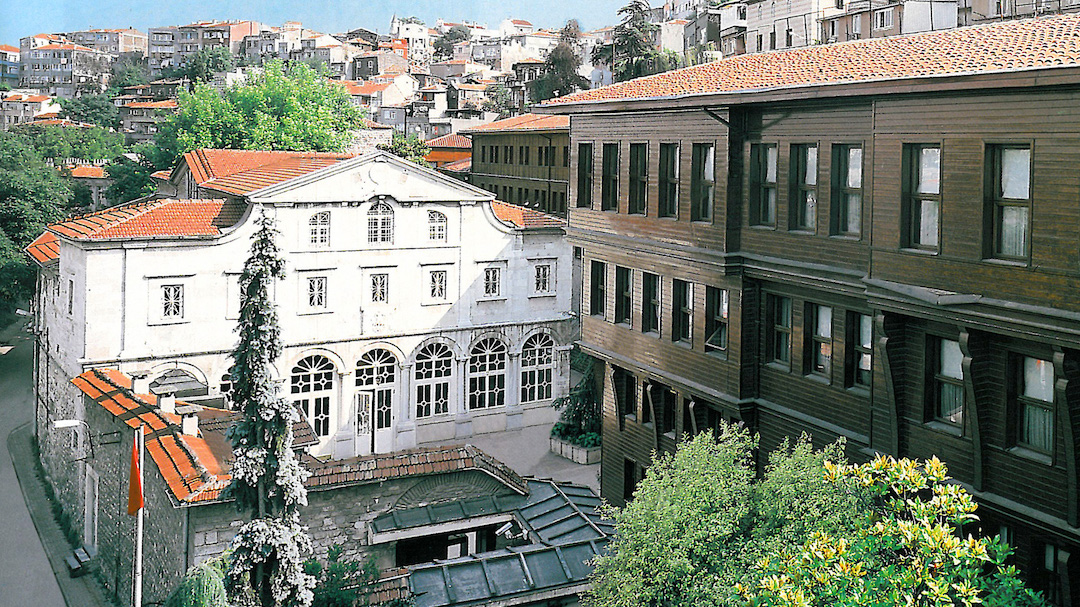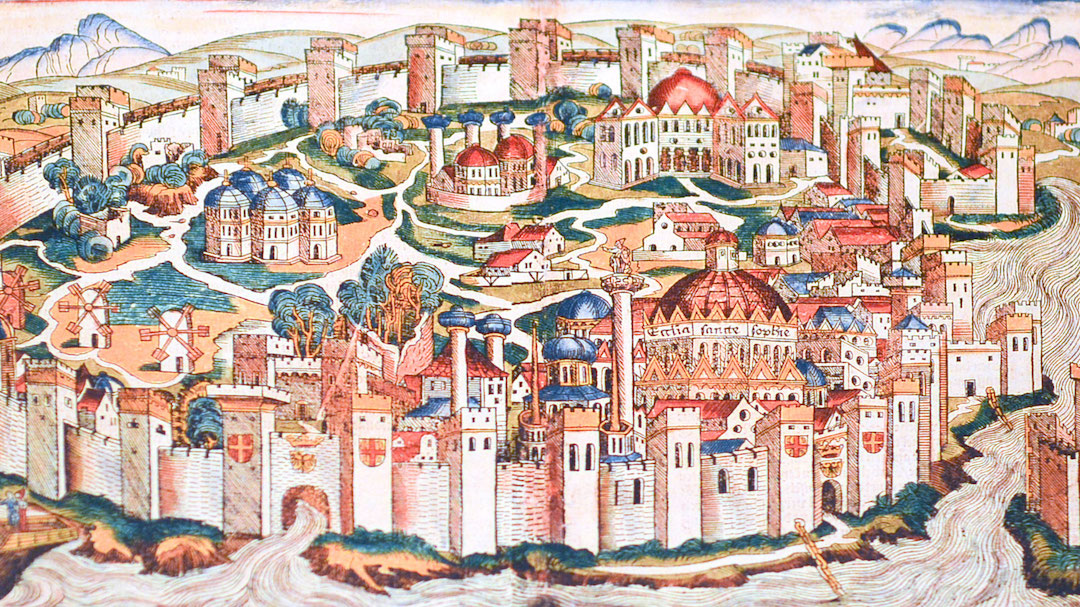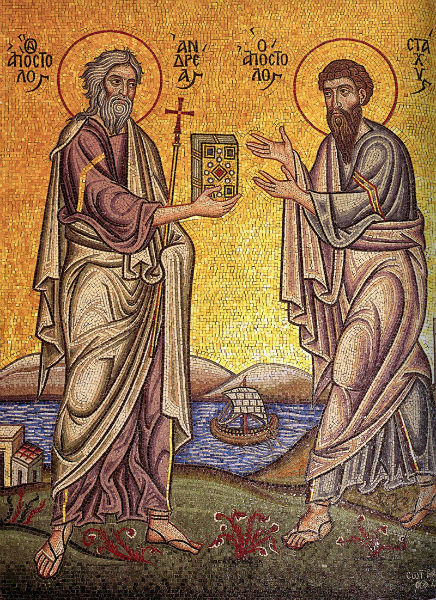Home » The Ecumenical Patriarchate
About the Ecumenical Patriarchate
About the Ecumenical Patriarchate

The Ecumenical Patriarchate is the highest see and holiest center of the Orthodox Christian Church throughout the world. It is an institution with a history spanning seventeen centuries, during which it retained its see in Constantinople (today’s Istanbul). It constitutes the center of all the local Orthodox churches, heading these not by administration but by virtue of its primacy in the ministry of pan-Orthodox unity and the coordination of the activity of the whole of Orthodoxy.
The function of the Ecumenical Patriarchate as center par excellence of the life of the entire Orthodox world emanates from its centuries-old ministry in the witness, protection, and outreach of the Orthodox faith. The Ecumenical Patriarchate, therefore, possesses a supra-national and supra-regional character. From this lofty consciousness and responsibility for the people of Christ, regardless of race and language, were born the new regional churches of the East for the diaspora, from the Caspian to the Baltics, and from the Balkans to central Europe. This activity today extends to the Americas, Asia, and Australia.
Orthodox Christians on all continents, which do not fall under the jurisdiction of the autocephalous (independent) or autonomous (semi-independent) churches, fall under the direct jurisdiction of the Ecumenical Patriarchate. The most important of the autocephalous churches are the ancient patriarchates of Constantinople, Alexandria, Antioch, and Jerusalem (together with the ancient Archdiocese of Mt. Sinai), the patriarchates of Russia, Serbia, Romania, Bulgaria, and Georgia, as well as the churches of Cyprus, Greece, Poland, Albania, and the Church of the Czech Lands and Slovakia. The churches granted autonomy by the Ecumenical Patriarchate include those of Finland and of Estonia. Consequently, the Orthodox churches in Europe, America, Australia, and Britain, which are not under the jurisdiction of the aforementioned autocephalous churches, lie within the jurisdiction of the Ecumenical Patriarchate. All Orthodox feel that they are constituents of one essentially spiritual community, wherein “when one member suffers, so do all.” It is a true sense of unity in diversity.
The Ecumenical Patriarchate through the Ages
The Ecumenical Patriarchate through the Ages

Following the establishment of Constantinople as the state capital of the Roman Empire by Emperor Constantine the Great (r. 306–37) in the early part of the fourth century, a series of significant ecclesiastical events saw the status of the bishop of New Rome, as the city was then called, elevated to its current position and privilege. The Church of Constantinople is traditionally regarded as being founded by St. Andrew, the “first-called” of the apostles. The third canon of the Second Ecumenical Council, held in Constantinople (381), conferred upon the bishop of this city second rank after the bishop of Rome. Less than a century later, the twenty-eighth canon of the Fourth Ecumenical Council, held in Chalcedon (today’s Kadıköy, on Istanbul’s Asian shore) in 451, offered Constantinople equal ranking to Rome and special responsibilities throughout the rest of the world, expanding its jurisdiction to territories hitherto unclaimed. Finally, the thirty-sixth canon of the Sixth Ecumenical Council, held in Constantinople (680–1), confirmed the primacy of the Ecumenical Patriarch, paving the way for his administrative jurisdiction and pastoral leadership. In this way, the Ecumenical Patriarchate granted independence to individual churches in later centuries—such as Russia (1589 and 1917), Serbia (1920), Romania (1925), Bulgaria (1961), Georgia (1990), Greece (1850), Poland (1924), Albania (1937), and the Czech Lands and Slovakia (1998).
 The Ecumenical Patriarchate holds a primacy of honor among these autocephalous, or ecclesiastically independent, churches. It enjoys the prerogative of serving as “first among equals.” It is also known as the “Roman” Patriarchate (hence the Turkish phrase Rum Patrikhanesi), recalling its historical source as the Church of New Rome, the new capital of the Roman Empire, transferred in 330 from old Rome to Byzantium by Constantine the Great. The first bishop of Byzantium was Stachys (38-54), a disciple of the apostle Andrew. In 330, the city was renamed Constantinople and New Rome (Nova Roma), while its bishopric was elevated to an archbishopric. The metropolitan of Heraclea (present-day Marmara Ereğlisi, in Turkey’s Tekirdağ province), to whom Byzantium was formerly subject, now came under the jurisdiction of Constantinople and enjoyed the privileges of the latter’s most senior see.
The Ecumenical Patriarchate holds a primacy of honor among these autocephalous, or ecclesiastically independent, churches. It enjoys the prerogative of serving as “first among equals.” It is also known as the “Roman” Patriarchate (hence the Turkish phrase Rum Patrikhanesi), recalling its historical source as the Church of New Rome, the new capital of the Roman Empire, transferred in 330 from old Rome to Byzantium by Constantine the Great. The first bishop of Byzantium was Stachys (38-54), a disciple of the apostle Andrew. In 330, the city was renamed Constantinople and New Rome (Nova Roma), while its bishopric was elevated to an archbishopric. The metropolitan of Heraclea (present-day Marmara Ereğlisi, in Turkey’s Tekirdağ province), to whom Byzantium was formerly subject, now came under the jurisdiction of Constantinople and enjoyed the privileges of the latter’s most senior see.
As a title, “Ecumenical Patriarchate” dates from the sixth century and belongs exclusively to the archbishop of Constantinople. The Great Schism of 1054—in fact the culmination of a gradual estrangement over many centuries—resulted in formal separation between the Churches of the East (now known as [Eastern] Orthodox Christianity) and the West (now known as Roman Catholicism), granting Constantinople authority and jurisdiction over the Orthodox churches throughout the world.
After the capture of Constantinople by the Latins during the Fourth Crusade (1204), the Ecumenical Patriarchate was transferred to Nicaea (present-day İznik) in 1206, but Emperor Michael VIII Palaeologos (r. 1259–82) restored it to Constantinople when he recaptured the city in 1261. When the city became the capital of the Ottoman Empire in 1453, the Ecumenical Patriarch (at the time, Gennadios II) was recognized as ethnarch, or leader, of the Orthodox peoples, with increased authority over the Eastern patriarchates and the Balkan churches, as well as farther afield.
From that time, the Ecumenical Patriarchate became a symbol of unity, rendering service and solidarity to the Eastern churches. In difficult periods, the Ecumenical Patriarchate was consulted for the resolution of problems. Frequently, patriarchs of other churches would reside in Constantinople, which was the venue for meetings of the Holy Synod that consisted of bishops from various churches and was chaired by the Ecumenical Patriarch.
The Ecumenical Patriarchate also sponsored missionary growth through the centuries, the most notable of which was the conversion of the Kievan Rus (a medieval Slavic state centered around Kiev, and the predecessor of modern Russia) in the tenth century and the most recent of which was the missionary work in southeast Asia in the last century. This pastoral role and responsibility has earned the characterization of the Ecumenical Patriarchate as “golden beacon of Orthodoxy, preserving the unwaning brilliance of Christianity.”
Currently, the Ecumenical Patriarchate is actively engaged in diverse ecclesiastical activities and ministries. It has historically proved to be a dynamic leader in the ecumenical movement, fully participating in the World Council of Churches (WCC) from its inception, as well as in local ecumenical bodies, instituting and chairing bilateral theological dialogues with non-Orthodox Christians but also with other monotheistic faiths.
About the Ecumenical Patriarchate

The Ecumenical Patriarchate is the highest see and holiest center of the Orthodox Christian Church throughout the world. It is an institution with a history spanning seventeen centuries, during which it retained its see in Constantinople (today’s Istanbul). It constitutes the center of all the local Orthodox churches, heading these not by administration but by virtue of its primacy in the ministry of pan-Orthodox unity and the coordination of the activity of the whole of Orthodoxy.
The function of the Ecumenical Patriarchate as center par excellence of the life of the entire Orthodox world emanates from its centuries-old ministry in the witness, protection, and outreach of the Orthodox faith. The Ecumenical Patriarchate, therefore, possesses a supra-national and supra-regional character. From this lofty consciousness and responsibility for the people of Christ, regardless of race and language, were born the new regional churches of the East for the diaspora, from the Caspian to the Baltics, and from the Balkans to central Europe. This activity today extends to the Americas, Asia, and Australia.
Orthodox Christians on all continents, which do not fall under the jurisdiction of the autocephalous (independent) or autonomous (semi-independent) churches, fall under the direct jurisdiction of the Ecumenical Patriarchate. The most important of the autocephalous churches are the ancient patriarchates of Constantinople, Alexandria, Antioch, and Jerusalem (together with the ancient Archdiocese of Mt. Sinai), the patriarchates of Russia, Serbia, Romania, Bulgaria, and Georgia, as well as the churches of Cyprus, Greece, Poland, Albania, and the Church of the Czech Lands and Slovakia. The churches granted autonomy by the Ecumenical Patriarchate include those of Finland and of Estonia. Consequently, the Orthodox churches in Europe, America, Australia, and Britain, which are not under the jurisdiction of the aforementioned autocephalous churches, lie within the jurisdiction of the Ecumenical Patriarchate. All Orthodox feel that they are constituents of one essentially spiritual community, wherein “when one member suffers, so do all.” It is a true sense of unity in diversity.
The Ecumenical Patriarchate through the Ages

Following the establishment of Constantinople as the state capital of the Roman Empire by Emperor Constantine the Great (r. 306–37) in the early part of the fourth century, a series of significant ecclesiastical events saw the status of the bishop of New Rome, as the city was then called, elevated to its current position and privilege. The Church of Constantinople is traditionally regarded as being founded by St. Andrew, the “first-called” of the apostles. The third canon of the Second Ecumenical Council, held in Constantinople (381), conferred upon the bishop of this city second rank after the bishop of Rome. Less than a century later, the twenty-eighth canon of the Fourth Ecumenical Council, held in Chalcedon (today’s Kadıköy, on Istanbul’s Asian shore) in 451, offered Constantinople equal ranking to Rome and special responsibilities throughout the rest of the world, expanding its jurisdiction to territories hitherto unclaimed. Finally, the thirty-sixth canon of the Sixth Ecumenical Council, held in Constantinople (680–1), confirmed the primacy of the Ecumenical Patriarch, paving the way for his administrative jurisdiction and pastoral leadership. In this way, the Ecumenical Patriarchate granted independence to individual churches in later centuries—such as Russia (1589 and 1917), Serbia (1920), Romania (1925), Bulgaria (1961), Georgia (1990), Greece (1850), Poland (1924), Albania (1937), and the Czech Lands and Slovakia (1998).
 The Ecumenical Patriarchate holds a primacy of honor among these autocephalous, or ecclesiastically independent, churches. It enjoys the prerogative of serving as “first among equals.” It is also known as the “Roman” Patriarchate (hence the Turkish phrase Rum Patrikhanesi), recalling its historical source as the Church of New Rome, the new capital of the Roman Empire, transferred in 330 from old Rome to Byzantium by Constantine the Great. The first bishop of Byzantium was Stachys (38-54), a disciple of the apostle Andrew. In 330, the city was renamed Constantinople and New Rome (Nova Roma), while its bishopric was elevated to an archbishopric. The metropolitan of Heraclea (present-day Marmara Ereğlisi, in Turkey’s Tekirdağ province), to whom Byzantium was formerly subject, now came under the jurisdiction of Constantinople and enjoyed the privileges of the latter’s most senior see.
The Ecumenical Patriarchate holds a primacy of honor among these autocephalous, or ecclesiastically independent, churches. It enjoys the prerogative of serving as “first among equals.” It is also known as the “Roman” Patriarchate (hence the Turkish phrase Rum Patrikhanesi), recalling its historical source as the Church of New Rome, the new capital of the Roman Empire, transferred in 330 from old Rome to Byzantium by Constantine the Great. The first bishop of Byzantium was Stachys (38-54), a disciple of the apostle Andrew. In 330, the city was renamed Constantinople and New Rome (Nova Roma), while its bishopric was elevated to an archbishopric. The metropolitan of Heraclea (present-day Marmara Ereğlisi, in Turkey’s Tekirdağ province), to whom Byzantium was formerly subject, now came under the jurisdiction of Constantinople and enjoyed the privileges of the latter’s most senior see.
As a title, “Ecumenical Patriarchate” dates from the sixth century and belongs exclusively to the archbishop of Constantinople. The Great Schism of 1054—in fact the culmination of a gradual estrangement over many centuries—resulted in formal separation between the Churches of the East (now known as [Eastern] Orthodox Christianity) and the West (now known as Roman Catholicism), granting Constantinople authority and jurisdiction over the Orthodox churches throughout the world.
After the capture of Constantinople by the Latins during the Fourth Crusade (1204), the Ecumenical Patriarchate was transferred to Nicaea (present-day İznik) in 1206, but Emperor Michael VIII Palaeologos (r. 1259–82) restored it to Constantinople when he recaptured the city in 1261. When the city became the capital of the Ottoman Empire in 1453, the Ecumenical Patriarch (at the time, Gennadios II) was recognized as ethnarch, or leader, of the Orthodox peoples, with increased authority over the Eastern patriarchates and the Balkan churches, as well as farther afield.
From that time, the Ecumenical Patriarchate became a symbol of unity, rendering service and solidarity to the Eastern churches. In difficult periods, the Ecumenical Patriarchate was consulted for the resolution of problems. Frequently, patriarchs of other churches would reside in Constantinople, which was the venue for meetings of the Holy Synod that consisted of bishops from various churches and was chaired by the Ecumenical Patriarch.
The Ecumenical Patriarchate also sponsored missionary growth through the centuries, the most notable of which was the conversion of the Kievan Rus (a medieval Slavic state centered around Kiev, and the predecessor of modern Russia) in the tenth century and the most recent of which was the missionary work in southeast Asia in the last century. This pastoral role and responsibility has earned the characterization of the Ecumenical Patriarchate as “golden beacon of Orthodoxy, preserving the unwaning brilliance of Christianity.”
Currently, the Ecumenical Patriarchate is actively engaged in diverse ecclesiastical activities and ministries. It has historically proved to be a dynamic leader in the ecumenical movement, fully participating in the World Council of Churches (WCC) from its inception, as well as in local ecumenical bodies, instituting and chairing bilateral theological dialogues with non-Orthodox Christians but also with other monotheistic faiths.
